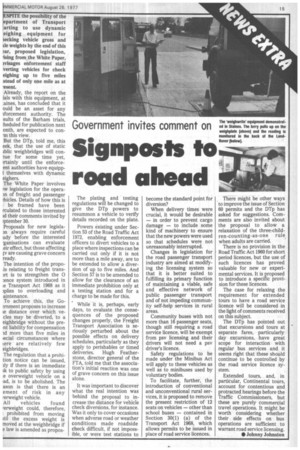Signposts to road ahead
Page 17

If you've noticed an error in this article please click here to report it so we can fix it.
ESPITE the possibility of the epartment of Transport arting to use dynamic eighing equipment for liecking vehicle gross and le weights by the end of this proposed legislation, ising from the White Paper, wisages enforcement staff verting vehicles for check eighing up to five miles ,stead of only one mile as at -esent.
Already, the report on the ials with this equipment, at :aines, has concluded that it ould be an asset for any iforcement authority. The ,sults of the Barham trials, :heduled for publication next onth, are expected to con-m this view.
But the DTp, told me, this eek, that the use of static Ablic weighbridges will conaue for some time yet, qtainly until the enforceent authorities have equipp themselves with dynamic eighers.
The White Paper involves !vy legislation for the operaMl of freight and passenger !hides. Details of how this is be framed have been rculated to those interested id their comments invited by ptember 30,
Proposals for new legisla3n always require careful udy before the interested .ganisations can evaluate ieir effect, but those affecting ;•v are causing grave concern ready.
The intention of the propoIs relating to freight trans)rt is to strengthen the 0 ence system introduced in le Transport Act 1968 as it )plies to overloading and aintenance.
To achieve this, the Gomliment proposes to increase le distance over which yedes may be diverted, to a eighbridge without the preait liability for compensation more than five miles in iecial circumstances where iere are relatively few eighbridges.
The regulation that a prohition notice can be issued, ily if there is an immediate 31( to public safety by using ie overweight vehicle on a lad, is to be abolished. The ason is that there is an ement of risk in any rerweight vehicle.
All vehicles found rerweight could, therefore, prohibited from moving itil the excess weight is moved at the weighbridge if e law is amended as propos The plating and testing regulations will be changed to give the DTp powers to resummon a vehicle to verify details recorded on the plate.
Powers existing under Section 53 of the Road Traffic Act 1972, enabling enforcement officers to divert vehicles to a place where inspections can be carried out only if it is not more than a mile away, are to be extended to allow a diversion of up to five miles. And Section 57 is to be amended to allow for the clearance of an immediate prohibition only at a testing station and for a charge to be made for this.
While it is, perhaps, early days, to evaluate the consequences of the proposed changes properly, the Freight Transport Association is seriously perturbed about the possible effects on delivery schedules, particularly as they apply to perishables or timed deliveries. Hugh Featherstone, director general of the FTA, told me that the association's initial reaction was one of grave concern on this issue alone.
It was important to discover what the real intention was behind the proposal to increase the distance for vehicle check diversions, for instance. Was it only to cover occasions when adverse road or weather conditions made roadside check difficult, if not impossible, or were test stations to become the standard point for diversion?
When delivery times were crucial, it would be desirable — in order to prevent cargo damage — to include some kind of machinery to ensure that the new powers were used so that schedules were not unreasonably interrupted.
Changes in legislation for the road passenger transport industry are aimed at modifying the licensing system so that it is better suited to fulfilling its primary function of maintaining a viable, safe and effective network of public passenger transport and of not impeding community self-help services in rural areas.
Community buses with not more than 16 passenger seats, though still requiring a road service licence, will be exempt from psv licensing and their drivers will not need a psv driver's licence.
Safety regulations to be made under the Minibus Act will apply to these vehicles as well as to minibuses used by voluntary bodies.
To facilitate, further, the introduction of conventional and unconventional rural services, it is proposed to remove the present restriction of 12 seats on vehicles — other than school buses — contained in Section 30(1) (a) of the Transport Act 1968, which allows permits to be issued in place of road service licences.
There might be other ways to improve the issue of Section 60 permits and the DTp has asked for suggestions. Comments are also invited about the proposal to allow a relaxation of the three-child
ren-counting -as-one rule, when adults are carried.
There is no provision in the • Road Traffic Act 1960 for short period licences, but the use of such licences has proved valuable for new or experimental services. It is proposed to introduce a specific provision for these licences.
The case for relaxing the requirement for extended tours to have a road service licence will be considered in the light of comments received on this subject.
The DTp has pointed out that excursions and tours at separate fares, particularly day excursions, have great scope for interaction with regular bus services and it seems right that these should continue to be controlled by the road service licence system.
Extended tours, and, in particular, Continental tours, account for contentious and protracted hearings before the Traffic Commissioners, but these are purely commercial travel operations. It might be worth considering whether their side effects on bus operations are sufficient to warrant road service licensing.
• Johnny Johnston












































































